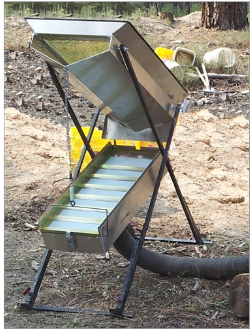Monday, February 01 2016
A drywasher is a machine that uses air, vibration, and static electricity to effectively separate gold from waste Drywashers are operated by shoveling gold-bearing gravels into an upper box which is covered with a screen. The larger rocks that are too big to pass through the screen slide off. Gravel small enough to go through is fed down into the lower gold recovery box, which is an inclined trough with cross riffles much like a sluice. The bottom of the recovery box consists of a thin, light-weight porous cloth. Beneath the riffle box is a blower that pulses air up through the cloth. The vibrations and air flow, combined with the shaking and classifying action of the dry washer allows the gold to settle to the bottom where it is captured in the riffles. With weather experts forecasting the strongest El Nino in half a century, dry washing should be very lucrative this winter. After being dry for so long, the predicted flash floods and high water events will replenish previously "worked out" areas. After all, nothing moves gold like water! Heavy rains and strong winds will cause erosion and mudslides that in turn move sands, gravel, rocks and even large boulders. The greater the volume and velocity of the water, the larger the gold and the further distance it will be moved until the water slows and the gold settles. As the fast-moving water eventually slows, "new" gold that has been unearthed will drop out of suspension and settle where it may, creating a layer of flood gold on or close to the surface. If El Nino is as strong as predicted, you'll find gold on the surface and maybe only 8 or 10 inches down, which means a lot less digging. Following a flash flood, you’ll often see black sand on the surface because it didn’t have enough time to work its way down. This clue tells you to do a test pan. You can dry pan or carry a little water. Test panning is a good idea even if the ground itself is too wet to drywash just yet. It’s never too wet to classify and prep the material to dry out in the sun! Once the floods are over and the dirt dries out, take advantage of the conditions and get out there with a drywasher. And when you do, keep these tips in mind:
NOTE TO CALIFORNIA PROSPECTORS: At a time when California legislators have refused to issue suction dredge permits to miners, dry washing may soon be the only unregulated activity left in the Golden State! With the new state-wide restrictions under Senate Bill 637 on the use of high bankers and suction dredges, some prospectors are starting to find a lot of gold deposits using dry washers in the California Mother Lode country. Good luck! Shop for a drywasher here and enjoy FREE SHIPPING in the Lower 48 on $350 purchases! Nugget of News Blog |
|
Nugget of News Blog |






